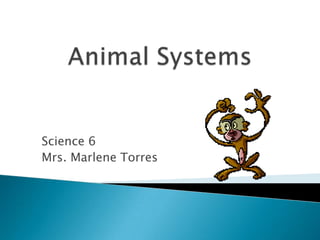
Animal Systems
- 1. Animal Systems Science 6 Mrs. Marlene Torres
- 4. Invertebrates have simple digestive systems. They can either: Filter food Have one opening -(to move food in and wastes out) Have 2 openings (“tube within a tube”) -one to move food in, other to move wastes out Digestion in Invertebrates
- 5. Digestion in Invertebrates Sponges belong to phylum Porifera
- 6. Flatworms (Example: Planaria) Digestion in Invertebrates
- 7. “Tube within a tube” system – 2 openings Example: Segmented worms-Earthworm Digestion in Invertebrates
- 8. Digestion in Vertebrates Vertebrates have complex digestive systems. They have many organs with different functions like crush, digest, absorb nutrients and water to obtain the energy from food.
- 11. Digestion in Vertebrates Frogs
- 14. Excretion is the removal of wastes from the body. Wastes have no value and may be poisonous to cells. Examples of wastes produced by animals: Carbon dioxide Salt excess Wastes from undigested food Urine Excretion
- 15. The removal of wastes is performed by many systems (or organs): Digestive System – eliminates the undigested with wastes Respiratory system – eliminates carbon dioxide Skin – eliminates salt excess and water Excretion
- 16. Excretion
- 17. Digestion itself, can not release the energy from the food molecules. It only brakes down large food molecules into smaller ones. Respiration is the process of releasing energy from food molecules in presence of oxygen. It occurs inside the cell. Respiration
- 18. Breathing Breathing is the action of moving air to the inside of the body and then, move air outside. In other words, inhale and exhale. Breathing provide the oxygen needed for respiration.
- 19. Respiration in Invertebrates The exchange of gases during respiration occurs by DIFFUSION. Diffusion refers to the movement of molecules from areas of higher concentration to areas of lower concentration.
- 21. The same situation occurs inside of the body around the cells.Respiration in Invertebrates
- 23. Flea respiratory system have a trachea, which consist of branching tubes that connects to all insect’s cells. Respiration in Invertebrates Flea
- 24. In vertebrates we can found gills and lungs, to provide the oxygen that will enter into each cell by diffusion. Fishes have gills. Amphibians are the only vertebrates that begins their life with gills, and develop lungs as adults BUT continue to exchange gases through their skin. Respiration in Vertebrates
- 25. Cartilaginous fishes Respiration in Vertebrates
- 26. Only BIRDS, REPTILES and MAMMALS use lungs exclusively for respiration. Respiration in Vertebrates
- 27. Respiratory system(Example of mammals – humans)
- 28. Remember: The digestive and respiratory systems work as a team to provide the food molecules and oxygen needed by the cell to produce energy. They can do it with the help of the Circulatory system.
- 29. Circulation The movement of important materials such as oxygen, glucose, and wastes throughout the body. REMEMBER: Glucose is the simplest form of sugar, and the “food” need by the cell to carry out respiration.
- 30. Circulation
- 31. Circulation
- 32. Body Temperature Cold-blooded animals The body temperature in cold-blooded animals changes with its environment. Examples: Amphibians Reptiles Most fishes
- 33. Body Temperature Warm-blooded animals The body temperature in warm-blooded animals stays the same, no matter what happens with the temperature of the air. If the temperature become to hot, warm-blooded animals give off the excess heat perspiring or sweating. In cold climates, we found thick layers of blubber to keep heat from escaping the body. Ex. Whales
- 34. Support and Movement There are three basic design that provide support and movement to animals: Hydrostatic skeleton (hydroskeleton) Exoskeleton Endoskeleton
- 35. Skeletons .